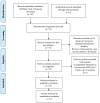Complement Inhibitors for Geographic Atrophy in Age-Related Macular Degeneration-A Systematic Review
- PMID: 39338244
- PMCID: PMC11432754
- DOI: 10.3390/jpm14090990
Complement Inhibitors for Geographic Atrophy in Age-Related Macular Degeneration-A Systematic Review
Abstract
Background/objectives: Age-related macular degeneration (AMD) is one of the main causes of blindness and visual impairment worldwide. Intravitreal complement inhibitors are an emergent approach in the treatment of AMD, which have had encouraging results. This systematic review analyzes the outcomes and safety of complement inhibitor therapies for GA in AMD cases.
Methods: A comprehensive search on the PubMed and Web of Science databases returned 18 studies involving various complement inhibitor agents, with a total of 4272 patients and a mean follow-up of 68.2 ± 20.4 weeks.
Results: Most treated patients were white (96.8%) and female (55.8%), with a mean age of 78.3 ± 7.8 years and a mean GA area of 8.0 ± 3.9 mm2. There were no differences in visual function change between treated and control participants. The mean GA area change was 2.4 ± 0.7 mm2 in treated participants vs. 2.7 ± 0.8 mm2 in control groups (p < 0.001). The ocular and systemic side effects were similar to those of intravitreal anti-VEGF. A less-understood effect was that of the onset of choroidal neovascularization (CNV) in 1.1-13% of patients; this effect was found to be more frequent in patients with neovascular AMD in the fellow eye or nonexudative CNV in the study eye at baseline.
Conclusions: Complement inhibitors may represent a useful therapy for GA in AMD, but a personalized approach to patient selection is necessary to optimize the outcomes.
Keywords: age-related macular degeneration; avacincaptad pegol; biomarkers; complement inhibitors; geographic atrophy; lampalizumab; outcomes; pegcetacoplan; personalized therapy.
Conflict of interest statement
Andreea Cristina Costea of Diaverum Nephrology and Dialysis Clinic Constanta was involved in the software and review and editing of the manuscript. The remaining authors declare that they have no commercial or financial relationships that could be perceived as a potential conflict of interest.
Figures





References
-
- Wong W.L., Su X., Li X., Cheung C.M., Klein R., Cheng C.Y., Wong T.Y. Global prevalence of age-related macular degeneration and disease burden projection for 2020 and 2040: A systematic review and meta-analysis. Lancet Glob. Health. 2014;2:e106–e116. doi: 10.1016/S2214-109X(13)70145-1. - DOI - PubMed
-
- Vision Loss Expert Group of the Global Burden of Disease Study. The GBD 2019 Blindness and Vision Impairment Collaborators Global estimates on the number of people blind or visually impaired by age-related macular degeneration: A meta-analysis from 2000 to 2020. Eye. 2024;38:2036–2046. doi: 10.1038/s41433-024-02995-5. - DOI - PMC - PubMed
-
- Varma R., Souied E.H., Tufail A., Tschosik E., Ferrara D., Zhang J., Silverman D., Dolan C., Bressler N.M. Maximum Reading Speed in Patients with Geographic Atrophy Secondary to Age-Related Macular Degeneration. Investig. Ophthalmol. Vis. Sci. 2018;59:AMD195–AMD201. doi: 10.1167/iovs.18-24238. - DOI - PubMed
Publication types
LinkOut - more resources
Full Text Sources

